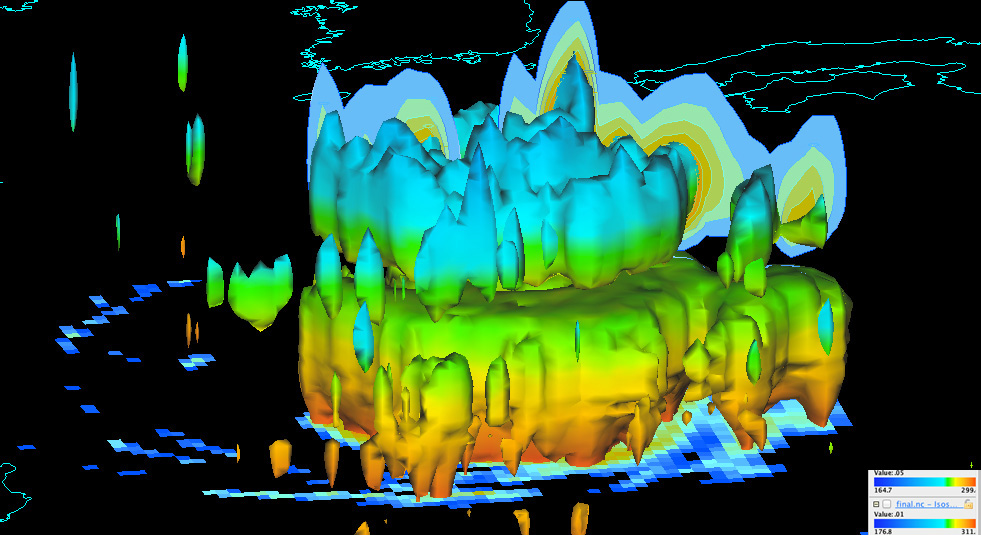Microwave Integrated Retrieval System (MIRS)
Algorithm Description
The Microwave Integrated Retrieval System (MiRS) is a physically-based microwave retrieval system designed to treat both atmospheric and surface parameters which affect passive microwave measurements. Some of the objectives of MiRS are (1) to perform the retrieval in all-weather conditions and (2) over all-surface types, with a major benefit being the extension of the spatial coverage to critically important active regions.
MiRS is a One-Dimensional Variational inversion algorithm (1DVAR) (Boukabara et al. 2011, 2013) that employs the Community Radiative Transfer Model (CRTM) as the forward and adjoint operators. It simultaneously solves for surface (T-skin, emissivity), and atmospheric parameters (temperature, water vapor, non- precipitating cloud and hydrometeor profiles).
In addition, once the core parameters of the state vector are retrieved in the 1DVAR minimization step, an additional post-processing is done in which a number of derived parameters are retrieved, based on inputs from the core 1DVAR retrieval. These include: surface rain rate, as well as cryospheric parameters such as snow pack properties, sea ice concentration and sea ice age.
Main Applications:
- Temperature and Water Vapor Sounding, for synoptic assessment and tropical cyclone intensity estimates;
- Water vapor profiles from 7 polar satellites used as inputs to blended TPW and layered water vapor products;
- Precipitation (rain rate) retrievals used as inputs to blended CPC rainfall analyses (CMORPH);
- Sea ice concentration and sea ice age for climate monitoring; and
- Snow water equivalent for monitoring global snowpack evolution.
Primary applications include temperature and water vapor sounding for synoptic weather assessments in clear and cloudy conditions; water vapor soundings serve as inputs to downstream applications such as the blended total precipitable water (TPW) and layer water vapor (LWV) algorithm that are also used for synoptic assessments and analysis of tropical cyclones. Precipitation (rain rate) retrievals are used as inputs to the Climate Prediction Center (CPC) blended high temporal and spatial resolution precipitation analysis (CMORPH). Precipitation rates are also important for estimating precipitation over ocean areas where conventional observations are not available. Both water vapor and precipitation products are highly useful in anticipating so-called atmospheric river events that can impact the US West Coast during winter. Sea ice concentration and sea ice age are useful in climate monitoring, and snow water equivalent estimates are useful for monitoring global snowpack evolution.
Key Users:
- National Hurricane Center (Hurricane Intensity Estimates, Blended Total Precipitable Water, Blended Layer Water Vapor)
- Weather Prediction Center (Blended Total Precipitable Water, Blended Layer Water Vapor)
- Climate Prediction Center (Precipitation)
MiRS key users include the National Hurricane Center (NHC) who utilizes the an algorithm for tropical cyclone intensity estimates that use as inputs MiRS profiles of temperature and water vapor. NHC also uses the Blended TPW and Layer Water Vapor products which are derived from inputs of MiRS water vapor profiles. The Weather Prediction Center also uses both Blended TPW and Layer Water Vapor in their operational forecasting activities. The Climate Prediction Center uses MiRS precipitation rate in their global high resolution blended precipitation analyses (CMORPH) that are updated every 30 minutes.
Algorithm PI
Principal Investigator
Quanhua (Mark) Liu
Operational Product Access
Monitoring and Algorithm Support
Other Relevant Links
List of satellite/instruments for algorithm
- NOAA-18 AMSU-A/MHS
- NOAA-19 AMSU-A/MHS
- Metop-A AMSU-A/MHS
- Metop-B AMSU-A/MHS
- S-NPP ATMS
- DMSP-F17 SSMI/S
- Megha-Tropiques SAPHIR
- GPM GMI

